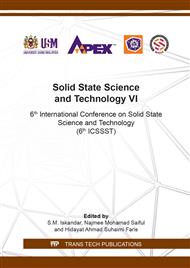p.183
p.193
p.199
p.208
p.214
p.220
p.227
p.233
p.239
Effect of Hydrazine on Formation of Bismuth Nanoparticles and its Properties as Pb Sensors
Abstract:
Bismuth nanoparticles (BiNPs) are of interest in many applications such as imaging, antimicrobial agent, biosensors and electrochemical electrodes. However, synthesis of pure bismuth is difficult as bismuth tend to oxidise and form bismuth oxide that affects its properties. In this work, BiNPs were synthesised using hydrothermal method in an autoclave at 160°C. The effect of hydrazine (N2H4•H2O) volume as reducing and capping agent was studied from 1.0-2.5ml with 3.6 Bi(NO3)3: 4.2 Polysodium 4-Styrene-Sulfonate: 50 H2O (mass ratio). The produced BiNPs was used to modify indium tin oxide (ITO) substrates and tested as electrochemical heavy metal sensors to detect Pb and As. Pure BiNPs were successfully produced in all hydrazine volume. However, size and crystallinity of BiNPs were influenced by volume of hydrazine. Among these changeable compositions, the mass ratio of Bi(NO3)3 to N2H4•H2O is the most important factor to form uniform size and shape of BiNPs. The addition of the reducing agent, N2H4•H2O into the precursor solution promoted the subsequent reduction of Bi(III) and enabled the growth of BiNPs. Cyclic voltammetry (CV) in 0.002 mol/L of K3Fe(CN)6 electrolyte showed peak current responses obtained for BiNPs/ITO modified electrodes are larger than the bare ITO electrode, which were attributed to the fact that the electrochemical activities of ITO electrode increased by BiNPs surface modification. Stripping current responses of the Differential Pulse Anodic Stripping Voltammetry measurements were recorded for the determination of Pb(II) after a 300 seconds of deposition time at −1.2 V in 0.002 mol/L of acetate buffer solution with pH 4.5. Sensitivity response for the detection of Pb(II) was achieved in the range from 2.5 to 100 μg/L. The limit of detection (LOD) is 2.5 μg/L for Pb(II).
Info:
Periodical:
Pages:
214-219
Citation:
Online since:
April 2019
Keywords:
Price:
Сopyright:
© 2019 Trans Tech Publications Ltd. All Rights Reserved
Share:
Citation:


